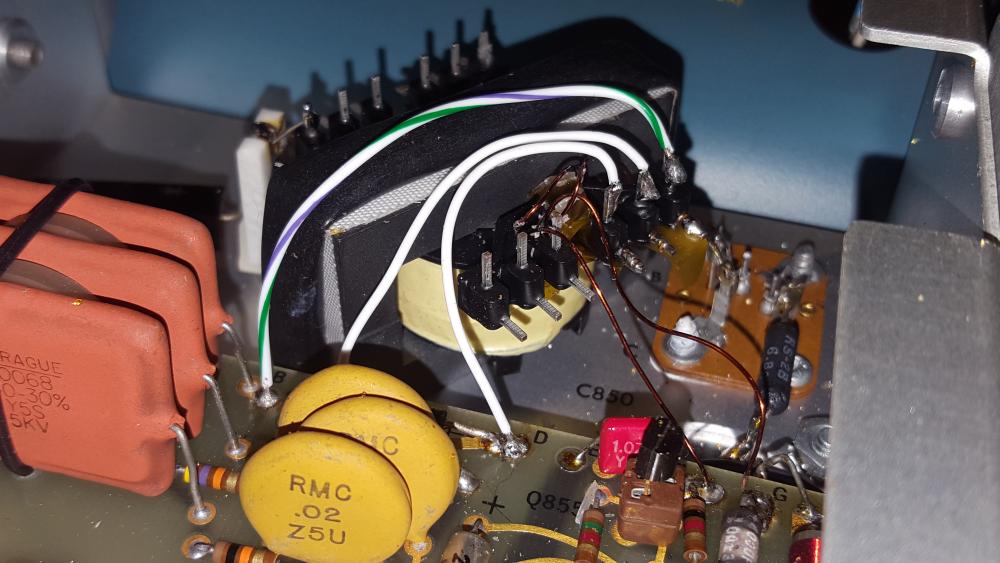-
Posts
5,470 -
Joined
-
Last visited
-
Days Won
33
Content Type
Profiles
Forums
Events
Everything posted by Craig Sawyers
-
No animal I know sleeps with such sheer abandon as a cat
-
39 of them. And two transistors (both germanium). I have two (don't ask) one with the hernia inducing 175 high current unit (internal wiring is welding cable). First time I used it I stuck a random TO220 on it, and without much effort at all blew a red hot heatsink tab across the room in a hail storm of hot epoxy shards. I've just resurrected a 576 - a much more useful all transistor tracer. Tek went through a brain dead period when they stopped wax potting their HV transformers and went over to epoxy potting. Alas in the late 60's epoxies were not too well developed, and degrade. Transformer overheats and then crowbars the LT supply feeding the oscillator. Tek woke up to this issue pretty quick, and soon turned over to silicone potting, which worked much better. So I rewound it. Bit of a faff, particularly the 1400T of 40AWG wire on the 2.7kV secondary. I wax potted it, and the 576 now works perfectly - needs a re-cal though. Sawyers re-wind in place. Left over ptfe sleeved wire lurking around from my T2 build
-
Have a truly great one!
-
There are ways around that problem, and also the tendency for distortion to increase significantly as you go down in frequency. Lundahl don't tend to mention this too loudly, but distortion of 0.1% at 50Hz and >0.5% distortion at 20Hz are not uncommon at higher drive levels (~5dBu). The way around this is to use the technique that Audio Precision do with their galvanically isolated inputs. This uses a very carefully designed transformer with auxiliary windings driven by an active circuit with negative output impedance. Patent is here http://www.google.co.uk/patents/US4614914 . It needs very careful design, because if anything is out of kilter it can of course make a very nice oscillator.
-
Among a roughly equal mix of great and dreadful things, one of his least glorious policies was his awful treatment of gays. That was something I did not know until a few days ago, when the ex-Mayor of London Ken Livingstone was interviewed on BBC Radio 4. Then I did a bit more reading about Castro, and it was quite correct. But put into the context of the time, when in the UK practicing gay guys were imprisoned for "gross indecency", or offered "chemical castration" as an alternative, it could be argued that gay persecution was a thing of its time globally.
-
Went to see this today http://www.nomanslandtheplay.com/ two titans of theatre - Ian McKellen and Patrick Stewart. Awesome. The performance is being broadcast live to cinemas worldwide on 15th December for anyone interested in a typical Tom Stoppard Harold Pinter play.
-
Why not buy a kit from eBay? This (Chinese) kit handles +/-34V at up to 2.5A http://www.ebay.com/itm/locky-zs-Intelligent-curve-tracer-PCB-New-/112168145773?hash=item1a1dbe136d:g:on8AAOSw4shYAujt Or a Tektronix 575 ebay 262701477638 which will does up to 200V/10A characteristics.
-
Wow. Back in the day he and Khrushchev were responsible for the world coming within a hair's breadth of nuclear Armageddon. Love him or hate him, he certainly left his mark on history writ large. RIP.
-
{pet rant mode} = on It was summed up by my boss years ago; in earlier days he was a racing driver, and he used to describe such people as "all dust and wheelspin, but no forward traction". The world is full of them - bullshit merchants with the appearance of glossy form, but no substance at all. Grinds my gears. {pet rant mode} = off
-

The Knuckledragger 3rd Memorial Slow Forum Post
Craig Sawyers replied to Knuckledragger's topic in Off Topic
I come from the North East of England, invaded over the years by various Scandinavian invaders. In my local dialect Kirkfjall is Church (Kirk) Hilll (Fjell) -
That is the only problem with the LX-Mini, it absolutely looks like a drain pipe and rubber coupler. The trick is disguising it to look less like what it is made from http://www.linkwitzlab.com/LXmini/Gallery.htm
-
It really shows how many outrageous speakers I've subjected my wife to over the years that she thinks the LX521 is a distinct improvement on what has gone before! Maggies, Martin-Logans, Podium 1; Quad ESL57. So yes - I can see where she's coming from!
-
It may seem perverse to consider building something, but these http://www.linkwitzlab.com/LXmini/Introduction.htm take a lot of beating, and can be built for not much more than $700 for drivers and all hardware, and including the DSP crossover. And you need four channels of amplification, which of course costs some more. Such as https://emotiva.com/products/amplifiers/xpa-gen3 for about $1k, but there are many options. You can get a kit from Madisound https://www.madisoundspeakerstore.com/2-way-speaker-kits/lxmini-linkwitz-lab-speaker-kit-pair/ for a number of kit options. Someone who had built a pair came along and we did a shoot out between the LX-mini and my LX-521. Apart from a comparative lack of bass, the imaging and neutrality were just as good.
-

The Knuckledragger 3rd Memorial Slow Forum Post
Craig Sawyers replied to Knuckledragger's topic in Off Topic
Farage is a dangerous fucker. And his involvement with Trump underlines that in spades. He has cultivated a cheeky chappy, beer drinking, man of the common people persona as head of UKIP (the UK Independence Party). But scrape the surface and you find that he made his money out of being a commondities broker. So not so much a man of the common people really. But, considering that UKIP have one single MP (out of 650), he commands a wholly disproportionate level of publicity. -
That is a big time in your son's life - congratulations to both you and him, Todd.
-
Hey - no sweat; you all gave us hope for a while
-

The Knuckledragger 3rd Memorial Slow Forum Post
Craig Sawyers replied to Knuckledragger's topic in Off Topic
It will be if relativistic baseball takes off http://what-if.xkcd.com/1/ -
Yup - the've got the budget, they've got the show - I'm pretty impressed with what I saw
-
If he did it is not in any google news feed.
-
Three days after the Grinning Man, we went to the (London) Old Vic last night to see Glenda Jackson as King Lear. There are actually two productions of King Lear in London at the moment, one with Jackson and one with Anthony Sher. The Jackson one was the real deal - with Celia Imrie as Goneril, Jane Horrox as Regan and Rhys Ifans (he was Spike in Notting Hill) as the Fool. It was uncut, starting at 7pm and ending at 10:30pm. Jackson has returned to the stage aged 80 after 23 years in politics as a Member of Parliament (Labour party). Another standing ovation. Absolutely stunning; a review here https://www.theguardian.com/stage/2016/nov/05/king-lear-review-glenda-jackson-old-vic .
-
-
-
Went to see The Grinning Man, a dark new musical based on a Victor Hugo's book The Man Who Laughs. This is at a small theatre called the Bristol Old Vic, the theatre that has been open the longest in the UK, opening its doors in 1766. The director of The Grinning Man is the same guy who directed War Horse It was bewilderingly good - I am still reeling at the whole experience. It was the last night - and it has only been running for one month. But that will not be the end for a production that was several years from first concept to the stage. I would say it was certainly destined for the West End, and for Broadway - For me it had more impact than Les Miserables, and deserves real success. A standing ovation, and tears shed by the audience, and oddly by the cast - although that was probably final night blues. There was a silent movie made of the book in 1928, and the story of facial disfigurement was the inspiration for The Joker. http://www.bristololdvic.org.uk/grinningman.html
-
That good sir would be most helpful - thanks!
-

The Knuckledragger 3rd Memorial Slow Forum Post
Craig Sawyers replied to Knuckledragger's topic in Off Topic
The definitive version, from the concert tour we saw. It has just reduced me to tears




